
Purple Sapphire Gemstone: Properties, Meanings, Value & More
 Everyone’s familiar with blue sapphires, but did you know that sapphires can look purple, too? That’s right! Not only are purple sapphires real, but they’re far harder to come by than their blue counterparts.
Everyone’s familiar with blue sapphires, but did you know that sapphires can look purple, too? That’s right! Not only are purple sapphires real, but they’re far harder to come by than their blue counterparts.
In addition to their rarity, purple sapphire gemstones are regarded as mystical talismans of good fortune and healing, despite their cryptic past.
If you’re intrigued to learn more about purple sapphire’s story, you’re in for a treat!
Join us as we dive deep into purple sapphire’s meanings, properties, mythology, pricing, and more in our Purple Sapphire Gemstone Guide.

About Purple Sapphire Stone
Besides the obvious, what else is a purple sapphire called? The precious gemstone also goes by “violet sapphire” or “plum sapphire,” to match its purple shades.
Like all sapphires, September babies can proudly sport purple sapphires as their traditional birthstones. It’s also the official zodiac stone for the astrological sign, Taurus.
In Ayurvedic (Hindu) astrology, Khooni Neelam characterizes a rare blue-violet sapphire with hints of crimson-red. This particular gem is a star stone for Saturn and Mars.
If you’re lucky to have found long-lasting love, purple sapphires make a meaningful, traditional 45th wedding anniversary gift.
But how can you tell if your purple sapphires are real? Its mineral traits can provide some insight.
Purple Sapphire Specifications & Characteristics
What are all the colors of sapphires? Many are surprised to learn that sapphires occur in almost every color of the rainbow — including purple!
Like all sapphires, they’re a variety of corundum, an aluminum oxide mineral. Corundum forms in prismatic tabular, bipyramidal, or rhombohedral crystals and granular or massive habits.
Interestingly, rubies also have the same composition as sapphires. The only distinction is their ruby-red color, resulting from a higher chromium presence.
But wait — if sapphires and rubies are technically the same minerals, why are rubies more valuable than sapphires? It’s because natural rubies are far rarer than most natural sapphires, making them more expensive.
Here’s an overview of purple sapphire’s mineral traits:
Chemical formula: Al2O3
Mineral family: Corundum
Composition: Aluminum oxide
Mohs hardness: 9
Color: Pinkish-lilac to varying purples to deep violet
Crystal structure: Hexagonal (trigonal)
Luster: Vitreous
Transparency: Transparent to nearly opaque
Refractive index: 1.76 to 1.77
Density: 3.99 to 4.1
Cleavage: None
Fracture: Uneven, conchoidal, or splintery
Tenacity: Brittle
Streak: Colorless
Luminescence: Fluorescent in all waves-UV (lilac to purple stones glow orange to red to blue; deep violet stones glow bluish-white)
Pleochroism: Weak to distinct (can show shifts of two shades of the body color)
Optical effects: Sometimes, asterism
Birefringence: 0.008 to 0.009
Dispersion: 0.018
Varieties: Color-changing (violet to blue)
It’s easy to confuse purple sapphires with other purple gemstones, especially the quartz variety amethyst.
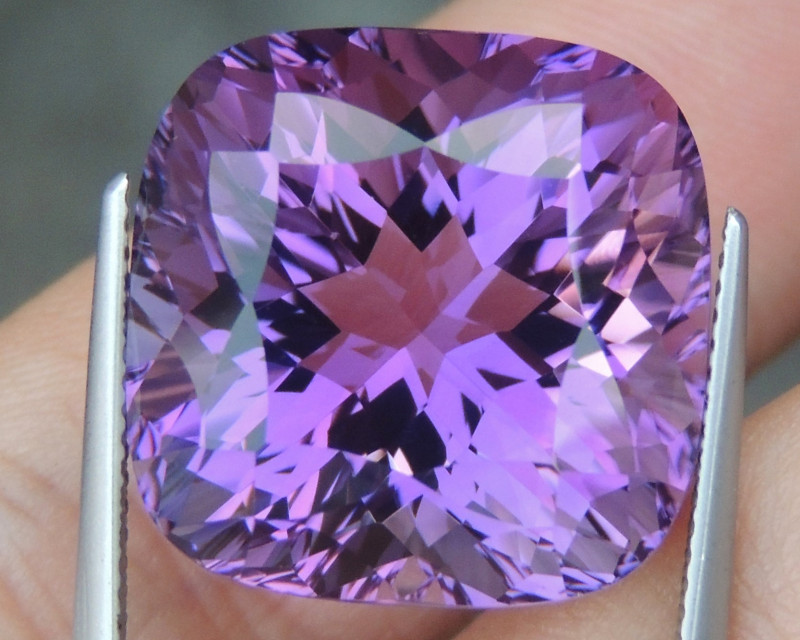 Pictured above: Amethyst
Pictured above: Amethyst
Purple Sapphire vs. Amethyst
How do you tell a purple sapphire from amethyst?
First, sapphires rank higher on the Mohs mineral hardness scale. They’re defined at 9, whereas amethyst registers at 7, making amethyst more prone to scratches.
In addition to better durability, sapphires are rarer and much more brilliant than amethyst. If you were to observe an amethyst and purple sapphire alongside one another, you’d find that purple sapphires have much more sparkle and clarity.
Amethyst also plays a role in some of the cryptic lore surrounding purple sapphire.
The Curse of the Delhi Purple Sapphire
In 1857, India was forced into mutiny against the British army. Amid the turmoil and looting, Bengal Cavalryman Colonel W. Ferris stole a purple “sapphire” from the Temple of Indra in Kanpur, India — later returning to England with the stolen gem.
As the legend goes, a stroke of bad luck followed Ferris home, from financial misfortunes to debilitating health problems plaguing his family. He gave the gem away after one of his relatives inexplicably committed suicide.
In 1890, the mysterious stone fell into the hands of scientist and writer Edward Heron-Allen. It wasn’t long before he, too, attributed his misfortunes to the cursed gem. In frustration, he cast the stone into a canal, hoping to be rid of it forever.
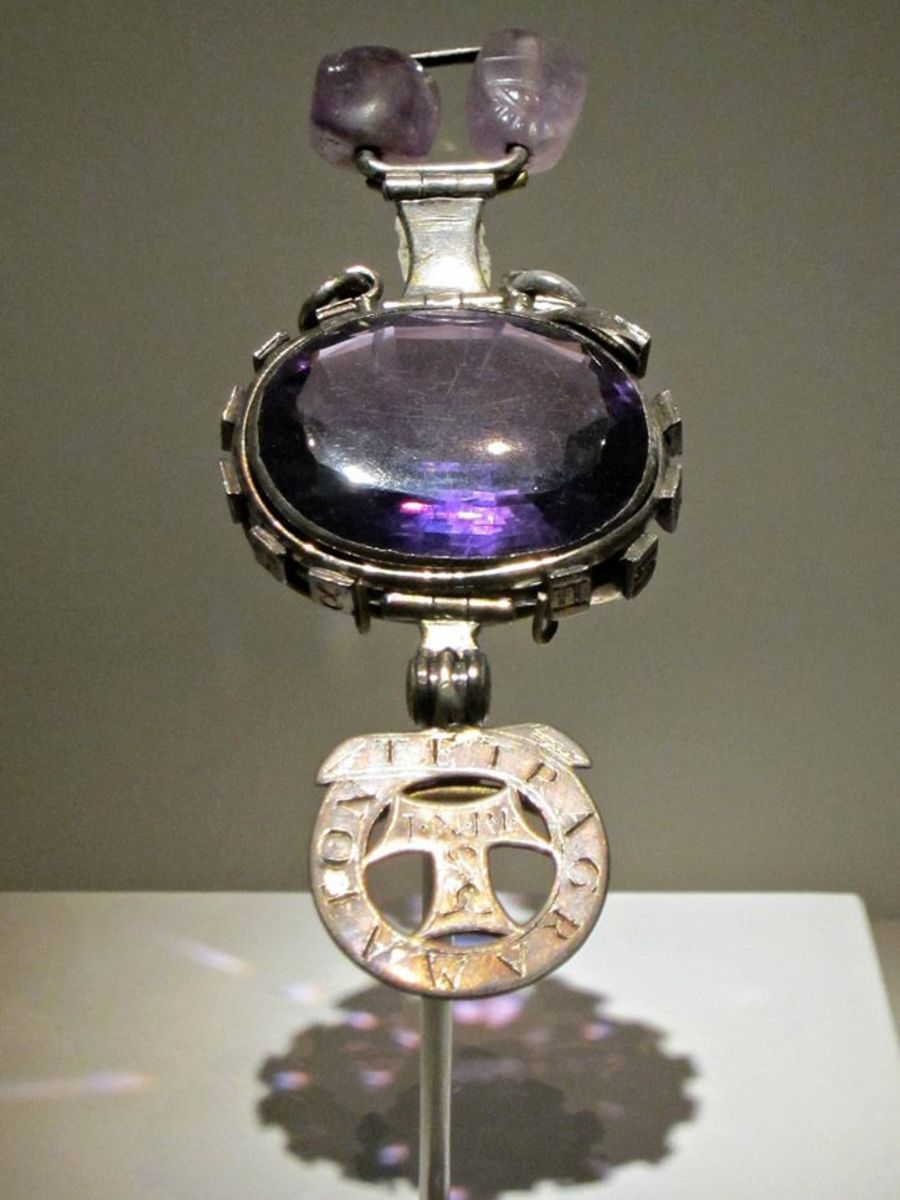 Pictured above: The Delhi purple "sapphire" on display
Pictured above: The Delhi purple "sapphire" on display
Shortly after, the gem was excavated from the canal and taken to a nearby jeweler. That jeweler immediately recognized the stone as one he’d mounted on a ring for his customer, Heron-Allen, and politely returned it to him.
Heron-Allen later lent it out to a friend. Unfortunately, the recipient was a celebrated singer who could never sing again after wearing the cursed gem.
Exasperated, Heron-Allen locked the jewel away in his bank deposit box surrounded by good luck charms. He enclosed a letter warning that the stone is “accursed and stained with the blood and dishonor of all who’ve owned it.”
Thirty-three years after Heron-Allen’s death, his daughter shipped the box to the Natural History Museum. It remained until 1972 when curator Peter Tandy uncovered the sapphire and the enclosed note detailing the tales of woe attached to the gem.
By then, gemological analysis was well-established, and the “sapphire” was discovered to actually be an amethyst.
Today, the Cursed Delhi Purple Sapphire permanently resides in London’s Natural History Museum's Vault Collection.
So, what are the metaphysical properties of purple sapphire today?

Purple Sapphire Healing Properties
While the Delhi Purple Sapphire is surrounded by spooky superstition, all other purple sapphires deliver only good vibes.
Like many crystals, purple sapphires do more than complement your aesthetic. This gem is a powerful healing stone to support your emotional and spiritual well-being. It’s said to be one of the most transformative sapphire varieties, enhancing your wellness in every aspect.
Emotionally, what are the benefits of purple sapphire?
Emotional Healing
Many believe the noble energies of purple sapphire melt away worry, stress, and anxiety. It unburdens your mind and quiets the inner voice that causes you to overthink and question your abilities.
This stone can inspire intuition, clarity, and self-mastery. By quieting the mind, purple sapphire keeps you focused, steady, and emotionally resilient. Hello, inner peace.
Spiritually, what do purple sapphires symbolize?
Chakra Healing
Dubbed the “Stone of Awakening”, healers use purple sapphire as a crown chakra stone, the hub of spirituality and higher connection.
Purple sapphire activates your crown chakra, enhancing your psychic and visionary growth. Meditating with this powerful stone may connect you to higher planes of existence and infuse you with energies of destiny, inspiration, and magic.
Now, how can you tell a good sapphire from a superior one? That’s where grading comes in.
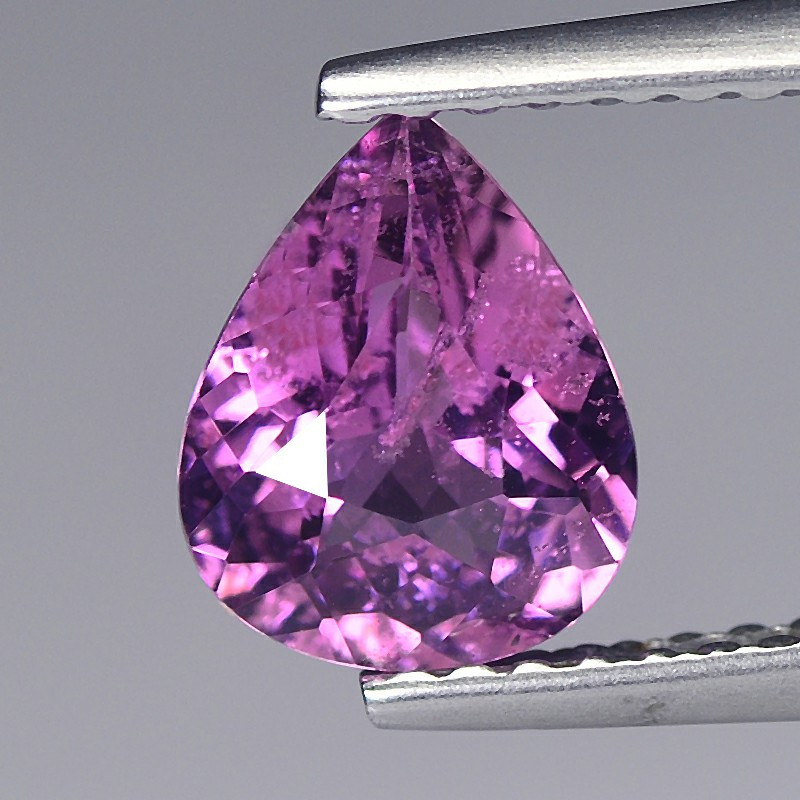
Purple Sapphire Gemstone Properties
Sapphires are graded based on color, cut, clarity, carat weight, and treatments.
Color
Purple sapphires occur in assorted shades, from soft lilac tones to deeper, more saturated plums and violets.
Purple sapphires are captivating already, but color-changing ones are even more so. This subtype can appear violet under daylight or fluorescent lighting but distinctly purple or blue under incandescent lights.
These color shifts are part of what makes purple sapphires so popular with gem connoisseurs. Many will pay premiums for specimens with strong to vivid saturation and an apparent color shift.
What is the rarest color of sapphire? Following highly-saturated blues, vivid pinks and purples are among sapphire’s rarest, most desirable hues.
Cut
Purple sapphire’s excellent hardness and durability allow lapidaries to experiment with all kinds of faceted cuts. You can find purple sapphires in basic shapes like oval, baguette, and round to fancier custom cuts.
Some sapphires display an optical phenomenon called asterism. These purple “star” sapphires contain inclusions that form a distinct star-like reflection against the gem’s strongly saturated color. These exceptional sapphires are cut as cabochons to exhibit the effect properly.
A more affordable alternative is an uncut purple sapphire. These specimens are equally beautiful and sold in assorted shapes and sizes, polished or unpolished, and generally sit at much more accessible price points.
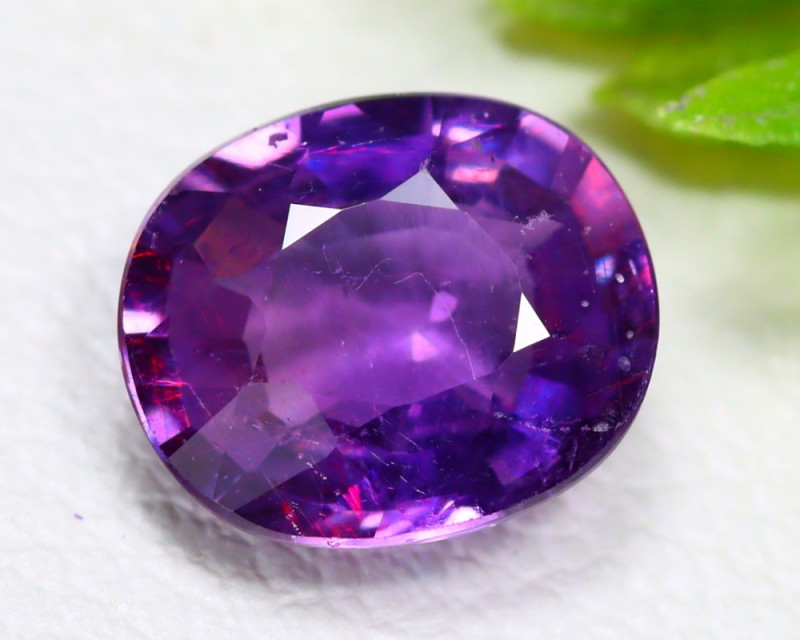
Clarity
A Type II colored gemstone clarity grade characterizes all natural, untreated sapphires. This means they typically have some minimal, visible inclusions. “Silk” inclusions (thread-like, typically rutile) are also common, lending a velvety look.
The lighter the purple, the more visible the inclusions.
Flawless, untreated purple sapphires with no inclusions are extremely rare and expensive. If you find one at a price that seems too good to be true, chances are it’s a simulant gem.
Carat Weight
Large commercial-quality purple sapphires are rare. Instead, most purple sapphires are just under 1 carat.
Treatments
Many sapphires are heat-treated to even out their color and deepen fainter-colored areas. These heat treatments also improve the gem’s clarity.
Unlike most sapphires, however, purple sapphires are known to have superb natural color saturation, rarely requiring any enhancements at all.

Purple Sapphire Formation & Sources
All sapphires start as corundum, forming over millions of years deep inside Earth’s crust. You’ll find them in metamorphic and igneous rocks.
Purple sapphires are colored by the presence of vanadium (which happens to be the fifth most abundant transition metal in Earth's crust).
Geographically, where are purple sapphires from?
Mining Locations
Today, Madagascar is best known for producing an amount of colorless corundum used in producing exceptional purple sapphires.
Other notable localities are:
India
Myanmar
Sri Lanka
Thailand
Knowing what the price of purple sapphire is will help you prep your budget.
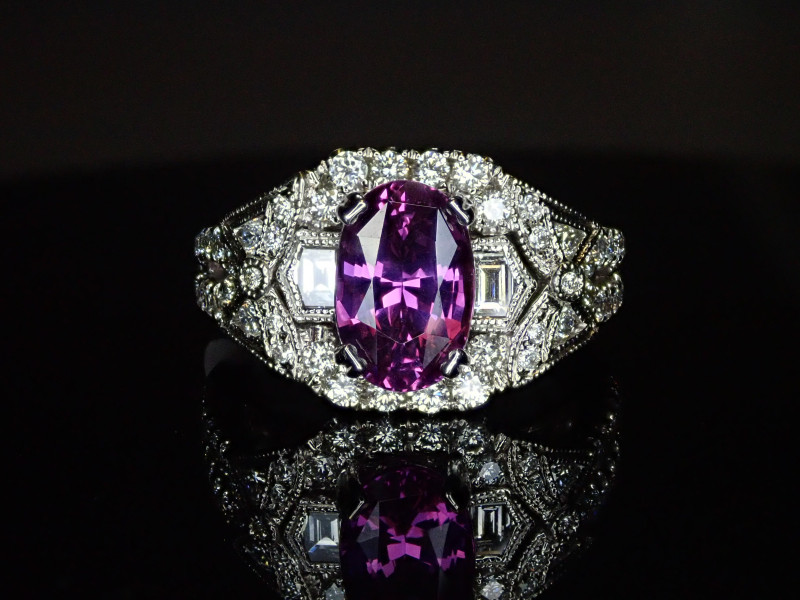
Purple Sapphire Price & Value
Are sapphires worth more than diamonds? No. Although sapphires aren’t quite the splurge that diamonds are, they don’t fall far behind in beauty or durability.
Comparing colors, purple sapphires typically fetch higher prices than their green and yellow cousins. However, they’re closer to blue sapphire prices. Thus, they fall somewhere in the mid-range price category alongside pink sapphires.
Faceted purple sapphires generally cost between $1,000 and $2,300 per carat. You can find lower-quality faceted options for $100 to $400 per carat. Exceptional faceted gems have reached $5,200 per carat.
Cabochons are slightly less expensive, averaging between $100 to $250 per carat. Star sapphire cabochons, however, can start at around $390 per carat.
On the other hand, raw purple sapphires are much more accessible. They typically wholesale for about $0.15 to $0.50 per carat. Lower-quality specimens can start at $0.03 per carat, while higher-quality ones can reach $20 per carat.
The price of purple sapphire jewelry varies. You can find rings, bracelets, and pendants starting at a few hundred dollars, reaching prices as high as $125,000.
In love with purple sapphires? Knowing how to care for your gemstones properly will ensure they endure a lifetime.
Purple Sapphire Care and Maintenance
Purple sapphires are the second hardest gem after diamonds, making them ideal for everyday wear. That said, they’re not entirely immune to damage either. Below are tips for keeping your purple sapphires as stunning as the day you acquired them.
Cleaning your purple sapphire gems is as easy as 1-2-3:
Use a simple solution of warm water and gentle soap
Gently scrub away impurities with a soft-bristled brush (like a toothbrush)
Rinse with clean water and gently dry with a soft, lint-free cloth
Store your purple sapphire in a cool, dark place out of the sun and away from harder gems. To be extra safe, opt for purple sapphire jewelry with protective settings.

Dare to Be Different with Purple Sapphire!
Their striking appearance catches your eye, but purple sapphire’s calming energy and wise light will capture your heart. As beautiful as they are enigmatic, their durability makes them an eclectic accessory to add a pop of color to your everyday ensembles.
At the very least, you’ll stand out with a bold purple sapphire that quiets your mind and leaves all who see it speechless.
Search the Gemstone Encyclopedia
Related Auctions
Related Articles
Originally the Birthstones or gemstones were associated with a zodiac sign or the month of a individuals birth. Find out what your stone is and view the stones we have for sale
8th Feb 2021
There are dozens of quartz and chalcedony gems with various colors and patterns. Learn all about quartz properties and every type of quartz, from amethyst and agate to plasma and phantom quartz!
15th Oct 2020
Hackmanite is a pink to violet sodalite gem known for its unique color-change and luminescence. Learn why hackmanite is special, from its rare qualities to the types of hackmanite jewelry available.
28th Mar 2018
Latest Articles
Yugawaralite is a rare colorless, white, or pinkish zeolite crystal named for its discovery in Yugawara, Japan. Here we uncover the multifaceted history, properties, prices, and uses of yugawaralite.
24th Mar 2025
Simpsonite is a lesser-known mineral known on the gem market for its durability, yellow-orange color, and rarity. Discover all the properties, uses, prices, and history of simpsonite.
3rd Mar 2025
Kurnakovite is a colorless crystal related to inderite and rarely faceted but known among collectors. Explore the mineral traits, history, prices, and more in this kurnakovite guide.
17th Feb 2025
Article Categories
How To's is where you will find helpful articles from gem Rock Auctions on how to cut gemstones, select gemstones and buy gemstones.
9 Articles





